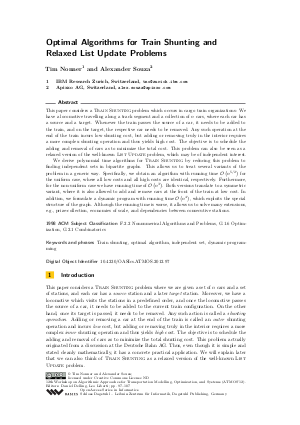Optimal Algorithms for Train Shunting and Relaxed List Update Problems
Authors Tim Nonner, Alexander Souza
-
Part of:
Volume:
12th Workshop on Algorithmic Approaches for Transportation Modelling, Optimization, and Systems (ATMOS 2012)
Part of: Series: Open Access Series in Informatics (OASIcs)
Part of: Conference: Symposium on Algorithmic Approaches for Transportation Modelling, Optimization, and Systems (ATMOS) - License:
 Creative Commons Attribution-NoDerivs 3.0 Unported license
Creative Commons Attribution-NoDerivs 3.0 Unported license
- Publication Date: 2012-09-13
File

PDF
OASIcs.ATMOS.2012.97.pdf
- Filesize: 417 kB
- 11 pages
Document Identifiers
Subject Classification
Keywords
- Train shunting
- optimal algorithm
- independent set
- dynamic programming
Metrics
- Access Statistics
-
Total Accesses (updated on a weekly basis)
0Document
0Metadata
Abstract
This paper considers a Train Shunting problem which occurs in cargo train organizations: We have a locomotive travelling along a track segment and a collection of n cars, where each car has a source and a target. Whenever the train passes the source of a car, it needs to be added to the train, and on the target, the respective car needs to be removed. Any such operation at the end of the train incurs low shunting cost, but adding or removing truly in the interior requires a more complex shunting operation and thus yields high cost. The objective is to schedule the adding and removal of cars as to minimize the total cost. This problem can also be seen as a relaxed version of the well-known List Update problem, which may be of independent interest.
We derive polynomial time algorithms for Train Shunting by reducing this problem to finding independent sets in bipartite graphs. This allows us to treat several variants of the problem in a generic way. Specifically, we obtain an algorithm with running time O(n^{5/2}) for the uniform case, where all low costs and all high costs are identical, respectively. Furthermore, for the non-uniform case we have running time of O(n^3). Both versions translate to a symmetric variant, where it is also allowed to add and remove cars at the front of the train at low cost. In addition, we formulate a dynamic program with running time O(n^4), which exploits the special structure of the graph. Although the running time is worse, it allows us to solve many extensions, e.g., prize-collection, economies of scale, and dependencies between consecutive stations.
Cite As Get BibTex
Tim Nonner and Alexander Souza. Optimal Algorithms for Train Shunting and Relaxed List Update Problems. In 12th Workshop on Algorithmic Approaches for Transportation Modelling, Optimization, and Systems. Open Access Series in Informatics (OASIcs), Volume 25, pp. 97-107, Schloss Dagstuhl – Leibniz-Zentrum für Informatik (2012)
https://doi.org/10.4230/OASIcs.ATMOS.2012.97
BibTex
@InProceedings{nonner_et_al:OASIcs.ATMOS.2012.97,
author = {Nonner, Tim and Souza, Alexander},
title = {{Optimal Algorithms for Train Shunting and Relaxed List Update Problems}},
booktitle = {12th Workshop on Algorithmic Approaches for Transportation Modelling, Optimization, and Systems},
pages = {97--107},
series = {Open Access Series in Informatics (OASIcs)},
ISBN = {978-3-939897-45-3},
ISSN = {2190-6807},
year = {2012},
volume = {25},
editor = {Delling, Daniel and Liberti, Leo},
publisher = {Schloss Dagstuhl -- Leibniz-Zentrum f{\"u}r Informatik},
address = {Dagstuhl, Germany},
URL = {https://drops.dagstuhl.de/entities/document/10.4230/OASIcs.ATMOS.2012.97},
URN = {urn:nbn:de:0030-drops-37066},
doi = {10.4230/OASIcs.ATMOS.2012.97},
annote = {Keywords: Train shunting, optimal algorithm, independent set, dynamic programming}
}
